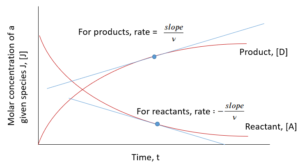11 Definitions of Reaction Rate and Extent of Reactions
Learning Objectives
By the end of this section, you should be able to:
Define Reaction rate and reaction extent
Calculate the reaction rate for the reaction, the rate of formation of compounds and the reaction extent
Reaction Rate
A reaction rate shows the rates of production of a chemical species. It can also show the rate of consumption of a species; for example, a reactant. In general though, we want an overall common reaction rate to describe changes in a chemical system.
Let’s look at an example. Say we have reaction represented as:
For this system reaction rate can be expressed as follows:
The reaction rate is represented by the letter “r” or the Greek letter upsilon “
NOTE: I will stick with r as upsilon looks like “
Above we have written the reaction rate as if a substance with a coefficient of 1 was reacting (or being produced). This is the typical form of an overall reaction rate describing a reaction.
Rearranging the above equation, we can find the rate of production/consumption for any species based on this overall reaction rate, note that stoichiometric coefficients are positive for products and negative for reactants:
The general equation for calculating the reaction rate:
General notation: J is used to denote any compound involved in the reaction.
Reaction rate at a given time can also be found from the graph of concentration of components in a system vs. time:

Exercise: Calculating the Reaction Rate
If we have the reaction
and we measure that the rate of formation of NO is 1.6 mmol/(L·s), what are the overall reaction rate, and the rate of formation of
Solution
Step 1: Determine the overall reaction rate from the rate of formation for NO.
Step 2: Use the reaction rate to determine rate of formation for the other compounds
NOTE: rate of formation is positive for products and negative for reactants
Reaction rates can be given in a variety of units over time. In this class we will just explore molarity and partial pressure, although other forms exist.
Molarity – molar concentration – expressed in units of
Partial pressure – the pressure produced by one gaseous component if it occupies the whole system volume at the same temperature, commonly used for gasses – units of
Extent of Reaction
We use the extent of reaction (
where:
We can get a relationship between the reaction extent and the rate of reaction when the system volume is constant:
where:
= volume


Feedback/Errata